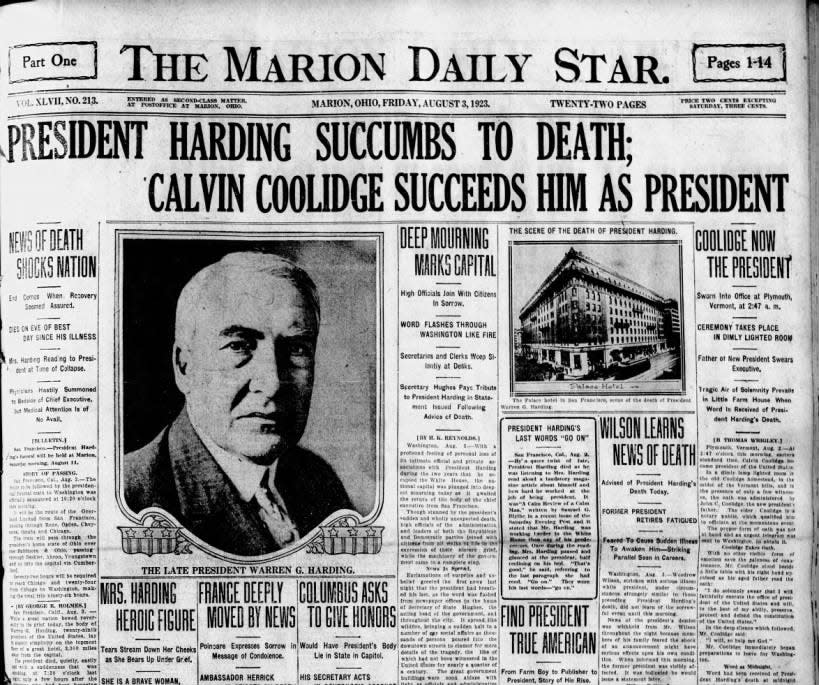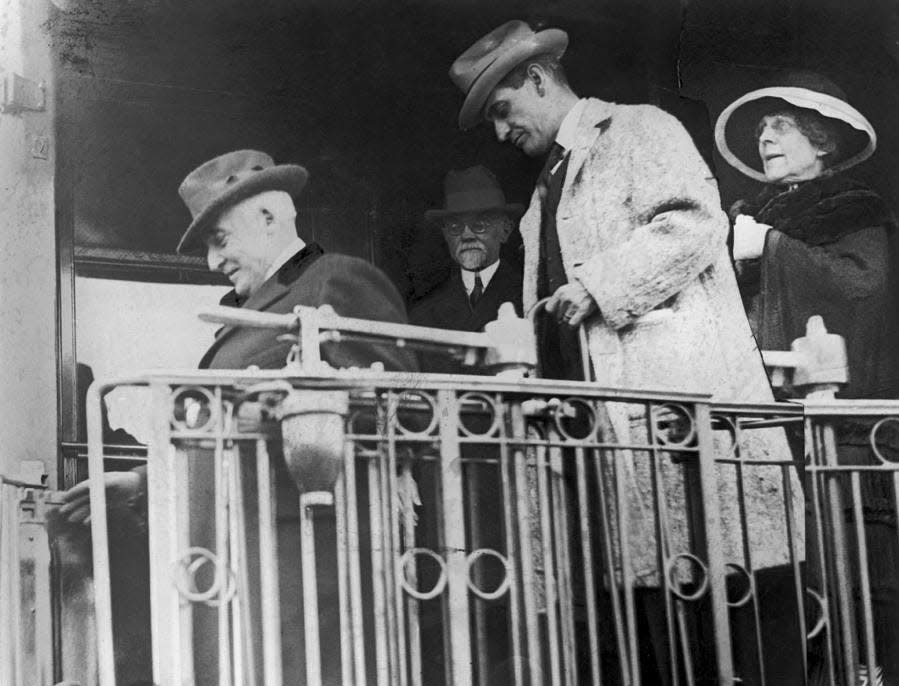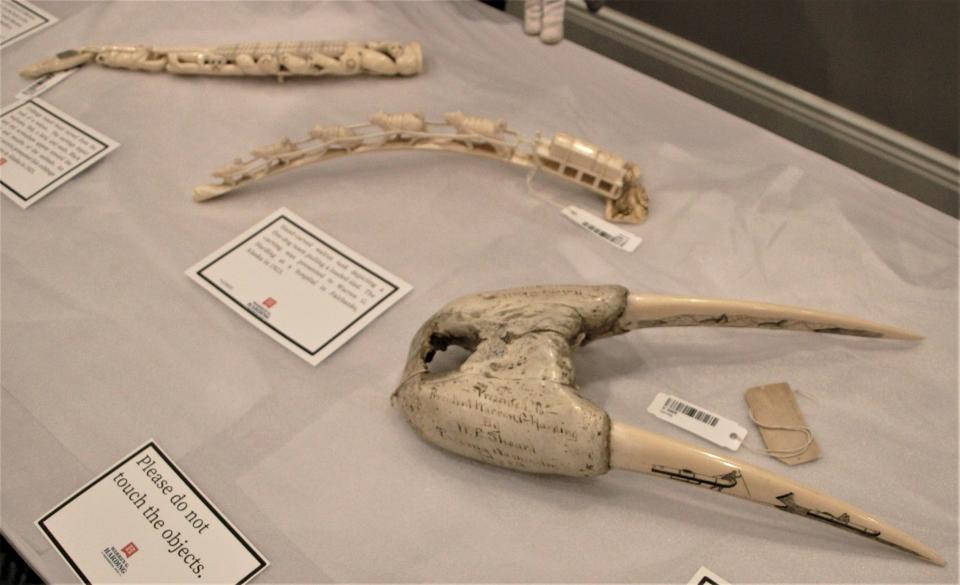Death of a President: Program marks 100th anniversary of Warren G. Harding's passing
- Oops!Something went wrong.Please try again later.
- Oops!Something went wrong.Please try again later.
Researchers shed some light on what precipitated the death of President Warren G. Harding during his "Voyage of Understanding" in the summer of 1923.
The Warren G. Harding Presidential Sites hosted the program "Death of a President: The Truths and Myths About President Harding's Last Days" on Aug. 2, the anniversary of his passing. Presenters included Dr. Richard Harding, one of the former president's grand-nephews; researcher Jon Andersen; and Harding Presidential Sites Manager Sherry Hall.
The "Voyage of Understanding" left Washington on June 20, 1923, and anticipated returning to the nation's capital on Aug. 20, Andersen said. He noted that Harding had a three-fold purpose for the trip: to let people see government (the president specifically) up close and personal; to meet with people where they lived and hear from them personally; and to determine what to do with the Alaska territory, which was still 26 years away from being granted statehood.

Health issues began early in 1923
Dr. Harding specifically addressed President Harding's health issues that first manifested early in January 1923. He noted that, according to historical records, the president was suffering from a variety of maladies including high blood pressure, issues with his gall bladder, chest pains, and pain that radiated down his left arm - all signs that Dr. Harding said pointed to possible cardiovascular disease.
However, the president's health issues were somewhat overshadowed by concerns about First Lady Florence Harding's health. Dr. Harding said the First Lady suffered from nephritis, inflammation of the kidneys. He said her physician believed she lived with only half capacity of her kidneys. Concerns about Mrs. Harding's health were so serious that a casket was taken on the trip to Alaska in case she died along the way, Dr. Harding said.
Members of the Hardings' inner circle believed that a March 1923 vacation to Miami, Florida, and the 15,000-mile long "Voyage of Understanding" would allow the couple to get much needed rest and relaxation, Dr. Harding explained. However, the president's schedule increased substantially because he insisted on taking time to meet with citizens in almost every community his train stopped in along the way.

Dr. Harding said between the scheduled speeches and impromptu talks the president decided to give at various stops, Harding held engaged in more than 100 public talks during the trip. That was on top of the many other activities the Hardings participated in, including horseback riding in Utah, golf outings, driving the ceremonial golden spike in the town of Nenana that signaled the completion of the Alaska Railroad, and other engagements.
It was recorded that President Harding said he was so weak that he could barely hold the hammer he used to drive in the golden spike during the ceremony in Nenana, Dr. Harding said.
Troubling turning point
Dr. Harding noted that the president's health took a significant downturn on July 27-28, 1923, during the return voyage south on the U.S.S. Henderson. The presidential party arrived in San Francisco on July 29, 1923, to prepare for the voyage back to Washington via the Panama Canal.
However, Dr. Joel Boone diagnosed Harding with an enlarged heart and low blood pressure, further signs of heart failure, Dr. Harding said. He noted that physicians did their best to treat the president over the last four days of his life, but lacked the knowledge and technology in that time to be able to properly diagnose and treat the ailments that resulted in Harding's death on Aug. 2, 1923, at the Palace Hotel.
Aftermath of the president's death
Harding's death elicited all types of emotional responses from people across the nation, Andersen said. Laddie Boy, the Hardings' Airedale terrier, even appeared to suffer from the shock of his master's death.
The president's passing and Laddie Boy's response prompted Edna Bell Seward, a journalist, author, poet, and lyricist, to pen the poem "Laddie Boy, He's Gone" to mark the occasion. It reads in part:
"Laddie Boy! you lie there list'ning
For a step that never comes
That noise rolling in the distance
Is the sound of fun'ral drums;
'Tis for him the man you worship
Do not strain brown eyes of love
Laddie Boy, your master's footsteps
Tread Celestial paths above."

Massive crowds gathered along the funeral train's route from San Francisco to Washington to pay their respects to the fallen commander in chief, Andersen said. It took four days for the funeral train to make its way back to the nation's capital. After ceremonies held in Washington, the president was transported back to Marion for burial.
Andersen showed a video taken from a motion picture recording of the train rolling through Chicago where thousands of people amassed alongside the tracks. Other photographs displayed during the presentation showed similar scenes as the train journeyed eastward.
Hall said one of the most frequently asked questions she receives is why no autopsy was conducted on the president. Dr. Harding noted that it was not normal procedure to conduct autopsies of presidents who died in office. He further stated that at the time of the president's passing in 1923, no questions about foul play were raised.
Andersen said unfounded allegations of foul play were later raised by infamous con man Gaston Means, resulting in the 1930 book "The Strange Death of President Harding," ghostwritten by Mae Dixon Thacker. His allegations that Mrs. Harding had poisoned the president were later refuted by Thacker, Andersen said.
How to view the presentation
The full presentation about President Harding's death can be viewed on the Harding Presidential Sites YouTube channel.
For more information about President Harding and his home, library, and museum located in Marion, go to the Harding Presidential Sites website hardingpresidentialsites.org.
Email: ecarter@gannett.com | Twitter: @AndrewACCarter
This article originally appeared on Marion Star: Program provides details about Warren G. Harding's final days

